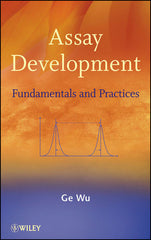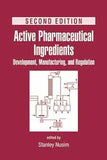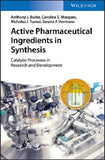Assay Development: Fundamentals and Practices by Ge Wu
Assay Development: Fundamentals and Practices
Essential principles and practice of assay development
The first comprehensive, integrated treatment of the subject, Assay Development: Fundamentals and Practices covers the essentials and techniques involved in carrying out an assay project in either a biotechnology/drug discovery setting or a platform setting.
Rather than attempting comprehensive coverage of all assay development technologies, the book introduces the most widely used assay development technologies and illustrates the art of assay development through a few commonly encountered biological targets in assay development (e.g., proteases, kinases, ion channels, and G protein-coupled receptors). Just enough biological background for these biological targets is provided so that the reader can follow the logics of assay development. Chapters discuss:
-
The basics of assay development, including foundational concepts and applications
-
Commonly used instrumental methods for both biochemical assays and cell-based assays
-
Assay strategies for protein binding and enzymatic activity
-
Cell-based assays
-
High-throughput screening
An in-depth study of the now popular Caliper's off-chip kinase assay provides an instructive, real-world example of the assay development process.
Chapter 1 Introduction to assay development.
1.1 Assay and Bioassay.
1.2 Drug discovery process and the role of assays in the process.
1.3 Bioassay development.
1.4 Bioassay Classifications.
Chapter 2 Measurement and Instrumentation.
2.1 Measurement and perturbation..
2.2 Common instrumental methods and instrument components.
2.3 Molecular absorption measurements.
2.4 Molecular luminescence measurements.
2.5 Luminescence lifetime measurement and time-resolved fluorescence (TRF) measurement..
2.6 Fluorescence resonance energy transfer (FRET) and TR-FRET.
2.7 Fluorescence quenching.
2.8 Fluorescence polarization.
2.9 Radioactivity measurement.
2.10 Evaluating and selecting an instrumental method for bioassay.
Chapter 3 Fundamental principles of assay with isolated proteins.
3.1 Chemical potential, equilibrium, and kinetics.
3.2 Protein binding studies at equilibrium.
3.3 Kinetic studies of protein binding process.
3.4 Enzyme kinetics.
3.5 Inhibition of protein function.
3.6 Assay development with isolated proteins.
Chapter 4 Separation-based techniques in bioassays.
4.1 Washing to remove impurity on solid support.
4.2 Organic extraction of hydrophobic molecules.
4.3 Centrifugation to remove dense particles.
4.4 Membrane filtration.
4.5 Liquid chromatography.
4.6 Electrophoresis.
Chapter 5 General protein binding assay formats.
5.1 Equilibrium dialysis.
5.2 Competitive binding assays with radioactive or other labeled ligands.
5.3 Application of SPATM and FlashplateTM in binding studies.
5.4 Application of FP assays in binding studies.
5.5 Application of FRET assays in binding studies.
5.6 Application of ELISA in binding studies.
5.7 Surface plasmon resonance (SPR) technology and its application in binding studies.
5.8 Application of label-free technologies in binding studies.
Chapter 6 Functional assays with isolated proteases.
6.1 Introduction to proteases and their substrates.
6.2 The function of proteases and their role drug discovery.
6.3 Protease assays.
6.4 Protease substrate profiling.
6.5 Protease inhibitors.
6.6 Assay development for caspases with fluorogenic substrate..
6.7 Assay development for Carboxypeptidase U..
Chapter 7 Functional assays with isolated kinases.
7.1 Introduction to protein kinases.
7.2 Substrates for in vitro kinase assays.
7.3 Kinase assay development strategies.
7.4 Kinase assay based on the detection of the phosphorylated product.
7.5 Kinase Assays by measuring the generation of ADP.
7.6 Kinase assays by measuring the depletion of ATP.
7.7 Kinase assays by measuring the depletion of peptide substrate.
7.8 Kinase assays by measurement of both product and substrate simultaneously.
7.9 An example of a kinase assay development in HTRF format..
Chapter 8 Fundamental principles of cell-based assays.
8.1 Cell signaling, signal transduction, and cellular responses.
8.2 General approaches in cell-based assays.
8.3 The concept of affinity and efficacy in cell-based assays.
8.4 Development of cell-based assays.
Chapter 9 Assays with ion channels.
9.1 Introduction to ion channels.
9.2 Strategies for ion channel assays.
9.3 Electrophysiological methods.
9.4 Ion flux methods.
9.5 Membrane potential sensing methods.
9.6 Selecting suitable assays for ion channel studies.
Chapter 10 Assays with G protein-coupled receptors.
10.1 Introduction to GPCRs and G proteins.
10.2. GPCR activation and signal transduction.
10.3 Strategies of GPCR assay development.
10.4 GPCR assays by measuring the extent of GTP binding to G?.
10.5 GPCR assays based on measurement of cAMP.
10.6 GPCR assays based on the measurement of intracellular inositol phospholipids.
10.7 GPCR assays based on the measurement of intracellular Ca2+.
10.8. GPCR assays based on the measurement of MAPK activity.
10.9. GPCR assays with reporter gene.
10.10 GPCR assays by monitoring events leading to GPCR internalization.
Chapter 11 Assays based on the integrated system properties of cells.
11.1. Cell viability, proliferation, and cytotoxicity assays.
11.2. Measurement of extracellular indicators of cellular metabolism.
11.3. Measurement of cell?s effect on electrical impedance.
11.4. Measurement of protein secretion from cells.
11.5. Measurement of discoloration of melanophore cells.
11.6. Measurement of cell motility.
Chapter 12 High content cell-based assay with optical imaging techniques.
12.1 Sample preparation.
12.2 Cellular image collection.
12.3 Image abstraction, analysis, and data management.
12.4 Applications of image-based cellular high content screening.
Chapter 13 High throughput screening.
13.1 Introduction to high throughput screening.
13.2 Molecular or cellular target and assay development.
13.3 Compound library management.
13.4 Hardware module.
13.5 Software module.
13.6 HTS operation management.
13.7 Building an HTS operation for biopharmaceutical discovery.
13.8 Quality control and data analysis in primary screening.
Chapter 14 A case study: The development of a microfluidic-based kinase assay platform.
14.1 Background of microfluidic technology and its application in bioassays.
14.2 The original Caliper?s mobility shift kinase assay format.
14.3 Realizing the flaws in Caliper?s original kinase assay format.
14.4 Searching for alternative kinase assay methods.
14.5 The development of the off-chip kinase assay format.
14.6 Current stage of microfluidic technology in bioassays.
14.7 Appendix: A poster presented in 2002 Society for Biomolecular Screening annual meeting.
Ge Wu, PhD, is Director of Assay Development at Iris International. He obtained his doctorate in biochemistry from UCLA, performed postdoctoral work at Harvard Medical School, and was a member of the faculty at Cornell University Medical College. Prior to joining Iris International, he worked at Merck & Co., Caliper Technologies, Amphora Discovery, and FivePrime Therapeutics. He is the founding Director of Assay Development and Screening at FivePrime Therapeutics. Dr. Wu is a leading figure in assay development and screening in biopharmaceutical discovery using primary cell assay and the author of an acclaimed review in this subject.
Related Products
-
A Practical Guide to Assay Devel...
13,464.00
16,830.00 -
A Textbook of Modern Toxicology,...
8,942.00
10,520.00 -
Active Pharmaceutical Ingredient...
3,200.00
3,495.00 -
Active Pharmaceutical Ingredient...
14,850.00
17,500.00 -
Advanced Distillation Technologi...
13,500.00
15,000.00 -
Aesthetics Exposed: Mastering Sk...
17,000.00
- Architecture & Construction Management Books
- Biochemistry, Bioengineering and Biotechnology Books
- Books on Analytical Techniques, GC MS, LC, TLC, HPLC, NMR Spectroscopy
- Books on Water and Wastewater Treatment, Analysis Water Treatment Plants
- Chemical Technology, Organic Chemistry, Chemical Synthesis and Chemical Analysis Books
- Cosmetics Science, Cosmetics Formulations, Manufacture and their Analysis Books
- Drugs and Pharma Science Books
- Essential Oils, their Analysis, Natural Products Extraction, Distillation , Isolates Related Books
- Flavor Science, Flavor Analysis, Flavor Creation, Food Flavors Books
- Food Science and Technology, Baking , Food Ingredients , Food Quality , Food Regulations
- Formulations of Perfumes for Agarbatti, Air Freshners, Soaps & Detergents, Fabric Softeners , French style Perfumes, Attars , OUD, Fine Fragrances
- Fragrances, Scents, Attars , Perfumery and Aroma Chemicals Books
- Herbal, Ayurvedic, Medicinal Plants and Aromatic Plants Books
- Law Books
- Major Reference Works (MRWS) Sets - MultiVolume Sets
- Medical Books
- Medical Journals Wolters Kluwer | Medknow India
- NEW ARRIVALS
- Perfumer's Resources
- Special Indian Reprint !


















